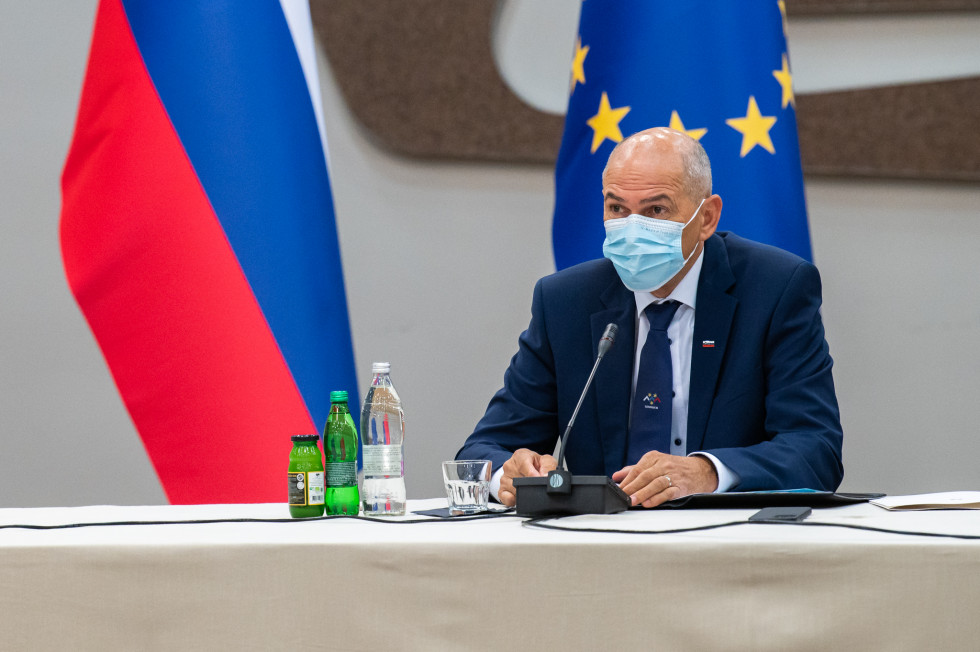Prime Minister Janša in the Savinjska Region
- Former Prime Minister Janez Janša (2020 - 2022)
- Government of the Republic of Slovenia

PM Janez Janša at a a working consultation in Podčetrtek. | Author Kabinet predsednika vlade
Since 1995, the natural population growth in the Savinjska region has been very similar to that in the whole of Slovenia. Following positive growth from 2005 to 2016, it has been negative in the last four years. The largest employment centre is Celje, followed by Velenje. 19,000 people from other municipalities in Slovenia come to work in Celje. Alongside Celje, Nazarje and Zreče are the municipalities featuring a distinctively high share of active working population. In June 2021, almost 33,000 people in the Savinjska region were employed in manufacturing. This is 6% more than a year ago. The Savinjska region also has 1,300 people employed in the mining industry. In 2020, the region recorded approximately 1.2 million tourist overnight stays, ranking third by region across Slovenia. Domestic tourists accounted for 77% of all overnight stays. The region has about 10,000 agricultural holdings cultivating almost 64,000 hectares of agricultural land. It has the third largest area of agricultural land by region and the second largest number of agricultural holdings. The average monthly net salary of those employed in the Savinjska region amounted to EUR 1,105 in 2020, which was approximately EUR 104 less than the Slovenian average.
The members of the Government first met for a working consultation in Podčetrtek, where the Mayor of the Podčetrtek Municipality, Peter Misja, gave an opening speech. The mayor commended a number of projects that are taking place in the municipality at the moment and pointed out that he was extremely pleased to welcome the Government on today’s visit to the municipality, the first since 2007. At the consultation, ministers spoke mainly about projects in the region in the fields of defence, economy, education, justice, culture, internal affairs, environment and spatial planning. The importance of spa tourism and projects implemented in the region within the framework of cohesion funds were given special focus.
In the municipality of Zreče, Prime Minister Janez Janša and the Mayor of Zreče, Boris Podvršnik spoke about the municipality's key projects as well as about its economic success, tourism and future projects. They also touched upon infrastructure projects and sustainable mobility measures. The talks also focused on the pilot project "Mesto generacij" (City of Generations) aimed at making connections, intergenerational cooperation and providing institutional care services for the elderly in Zreče.
Peter Dermol, the Mayor of Velenje and the Prime Minister mainly discussed the restructuring of the Savinjska region and the fair transition, as well as infrastructure and other projects and investments in Velenje and the wider region. Prime Minister Janša and Mayor Dermol also talked about health care in Velenje, acquisition of funds and the Recovery and Resilience Facility. They also devoted some attention to the issue and importance of decentralisation.
The Prime Minister also visited the Diocese of Celje where he met with the Bishop of Celje, Msgr Dr Maksimiljan Matjaž. They discussed the work of the Celje-based charity, Caritas, vulnerable groups, the importance of the Teharje Memorial Park and the preservation of religious cultural heritage as part of Slovenian identity. Afterwards, the Prime Minister stopped in the bookstore of Celjska Mohorjeva družba. The publishing house Mohorjeva družba is celebrating its 170th anniversary this year and its management is extremely proud of this milestone.
Prime Minister Janez Janša also met with the Mayor of Celje, Bojan Šrot. The two discussed an environmentally significant topic, the rehabilitation of the Celje basin, a project that addresses the area's legacy of heavy industry. They also spoke about the issue of lump sum payments for municipalities, and considered the epidemiological situation, the healthcare situation and the issue of long-term care.
The visit to the Savinjska region concluded with a public debate in Celje, where the region's development actors talked about the region's challenges and opportunities.

